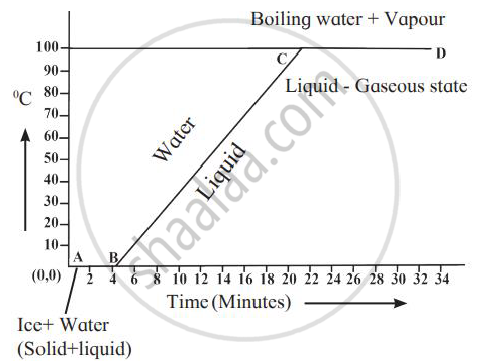Advertisements
Advertisements
प्रश्न
Derive an expression for the amount of heat given out or taken up, when its temperature falls or rises by t°C.
उत्तर
Let the mass of the body be ‘m’ and its specific heat capacity be ‘s’. It t°C is the rise in its temperature, then heat taken up by the body is calculated as below:
Since ‘s’ is the specific heat capacity of the body which means that the unit mass of the body for a rise of 1°C takes up ‘s’ amount of heat.
∴ Mass ‘m’ of the body for a rise of t°C will need heat
= m × s × t
= Mass of the body × Its specific heat × Rise in the temperature
= mst joule.
APPEARS IN
संबंधित प्रश्न
State any two measures to minimize the impact of global warming.
What is the energy absorbed during the phase change called?
The S.I. unit of specific latent heat is ______.
A molten metal of mass 150 g is kept at its melting point 800℃. When it is allowed to freeze at the same temperature, it gives out 75,000 J of heat energy.
- What is the specific latent heat of the metal?
- If the specific heat capacity of metal is 200 J kg-1 K-1, how much additional heat energy will the metal give out in cooling to -50℃?
Liquid ammonia is used in ice factory for making ice from water. If water at 20°C is to be converted into 2 kg ice at 0°C, how many grams of ammonia are to be evaporated? (Given: The latent heat of vaporization of ammonia = 341 cal/g)
When a liquid is getting converted into solid, the latent heat is ………………………………
Explain the following temperature vs time graph.

What happens to the heat supplied to a substance when the heat supplied causes no change in the temperature of the substance?
When 1 g of ice at 0 °C melts to form 1 g of water at 0 °C then, is the latent heat absorbed by the ice or given out by it?
Why water get cooled in a ‘Surahi’ in hot season?
Steam at 100°C is passed over 1000 g of ice at 0°C. After some time, 600 g of ice at 0°C is left and 450 g of water at 0°C is formed. Calculate the specific latent heat of vaporization of steam (Given: specific heat capacity of water = 4200 J/kg°C, specific latent heat of fusion of ice = 336,000 J/kg.)
1 kg of water is contained in a 1.25 kW kettle. Assuming specific heat capacity of water = 4.2 J/g °C and specific latent heat of vaporization = 2260 J/g, calculate:
(i) the time taken for the temperature of water to rise from 25°C to its boiling point,
(ii) the mass of water which evaporates per minute from the boiling water.
Find the odd one out and give its explanation.
Define boiling point of a liquid.
Write scientific reason.
Even if boiling water is constantly heated, its temperature does not rise.
Specific latent heat L = ______.
600 g of copper at 50°C is mixed with lOOOg water at 20°C. Find the final temperature of the mixture. The specific heat capacity of copper is 0.4 Jg-1°C-1 and that of water is 4.2 Jg-1°C-1
Specific latent heat of a substance ______.
Calculate the total amount of heat energy required to melt 200 g of ice at 0°C to water at 100°C. (Specific latent heat of ice = 336 Jg-1, specific heat capacity of water = 4.2 Jg-1 °C-1)
